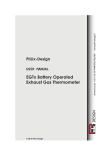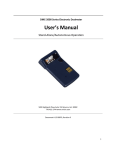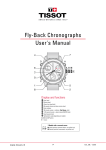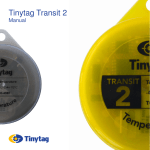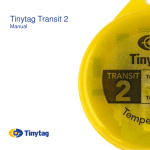Transcript
Technical Support (866) 908-TECH EV-DW4955: Wireless Mini Door/Window Contact USER MANUAL Powering the EV-DW4955 For your added convenience, the EV-DW4955 comes with the battery pre- installed. To activate, hold the EV-DW4955 firmly in one hand and pull the plastic tab in the direction indicated. Locate Transmitter Select the location where the EV-DW4955 is to be mounted. NOTE: RF signals can be affected by metal objects, including metal doors or large mirrors. Such locations should be avoided as they can interfere with proper operation. Enrolling, Programming and Placement Enroll the EV-DW4955 by programming the 6- digit serial number (located on the EV-DW4955) into the receiver. Once the EV-DW4955 is enrolled, you must perform a Module Placement test to ensure the location you have chosen is suitable. Please refer to your receiver Installation Manual for details. Mounting the EV-DW4955 and Magnet Once you have determined the proper location (see Enrolling, Programming and Placement), the EV-DW4955 can be permanently mounted. NOTE: It is the responsibility of the installer to ensure that the EV-DW4955 is securely mounted in the intended location. PAGE 1 Using Provided Screws: Remove the back from the transmitter (Figure A). Mount the back housing of the EV-DW4955, using the screws supplied, to the desired location. To remove cover, insert screwdriver here and gently twist. FIGURE A Using Adhesive Tape: Ensure that the surface is clean and dry. Apply the tape to the back of the EV-DW4955, press and hold firmly in the desired location for approximately 10- 15s. It can take up to 24h for the tape to reach maximum bonding strength. Align the magnet with the notched arrow on the EV-DW4955 housing (see Figure B). Mount the magnet a maximum of 5/ 8" (1. 8cm) from the EV-DW4955 by using the provided tape or screws. If necessary use the spacers provided. Once the EV-DW4955 and magnet are mounted, open and close the window/ door to ensure that none of the parts interfere with this movement. Only one magnet can be used for each EV-DW4955. NOTE : The adhesive tape is not to be used in UL Installations. FIGURE B Magnet 5/ 8" space max. (1.8cm) Reed switch on underside of PC Board (in unit). Symbol on side of the case indicates location of reed switch Out of the box the EV-DW4955 comes equipped with case tamper detection. If the case is removed, the EV-DW4955 will report a zone tamper to the control panel. For added security the EV-DW4955 was designed to provide wall tamper monitoring as well. Simply replace the short rubber actuator (see Figure C) with the longer one that is included. With this option, if the case is opened or if the EV-DW4955 is removed from it's location, a tamper will be sent to the control panel. It is strongly recommended that mounting screws be used when using the wall tamper option. FIGURE C Replacing the Battery The EV-DW4955 requires one Renata CR2450N lithium battery. To replace the battery, remove the cover as indicated in Figure A. Once cover is removed, the battery will be visible. To remove battery, insert a flathead screwdriver under the battery and gently twist (please refer to Figure D for details). Wait 90 seconds then install the new battery, placing positive side (+) up. WARNING!: Battery may explode if mistreated. Do not recharge, disassemble or dispose of in fire. PAGE 2 This device complies with part 15 of the FCC Rules. Operation is subject to the following two conditions: (1) This device may not cause harmful interference, and (2) this device must accept any interference received, including interference that may cause undesired operation. Any changes or modifications not expressly approved by the party responsible for compliance could void the user's authority to operate the equipment EV-DW4955 with back cover off FIGURE D Tamper Switch PAGE 3 Tamper location + Battery (+ side up) Insert screwdriver here, gently twist PC Board Federal Communications Commission (FCC) Statement This equipment has been tested to FCC requirements and has been found acceptable for use. The FCC requires the following statement for your information: This equipment generates and uses radio frequency energy and if not installed and used properly, that is, in strict accordance with the manufacturer's instructions, may cause interference to radio and television reception. It has been type tested and found to comply with the limits for a Class B computing device in accordance with the specifications in Part 15 of FCC Rules, which are designed to provide reasonable protection against such interference in a residential installation. However, there is no guarantee that interference will not occur in a particular installation. If this equipment does cause interferences to radio or television reception, which can be determined by turning the equipment off and on, the user is encouraged to try to correct the interference by one or more of the following measures: • If using an indoor antenna, have a quality outdoor antenna installed. • Reorient the receiving antenna until interference is reduced or eliminated • Move the receiver away from the control/communicator. • Move the antenna leads away from any wire runs to the control/communicator. • Plug the control/communicator into a different outlet so that it and the receiver are on different branch circuits. If necessary, the user should consult the dealer or an experienced radio/television technician for additional suggestions. The user or installer may find the following booklets prepared by the Federal Communications Commission helpful: “Interference Handbook”. This booklet is available from the U.S. Government Printing Office, Washington, DC 20402. The user shall not make any changes or modifications to the equipment unless authorized by the installation instructions or User’s Manual. Unauthorized changes or modifications could void the user’s authority to operate the equipment. PAGE 4
